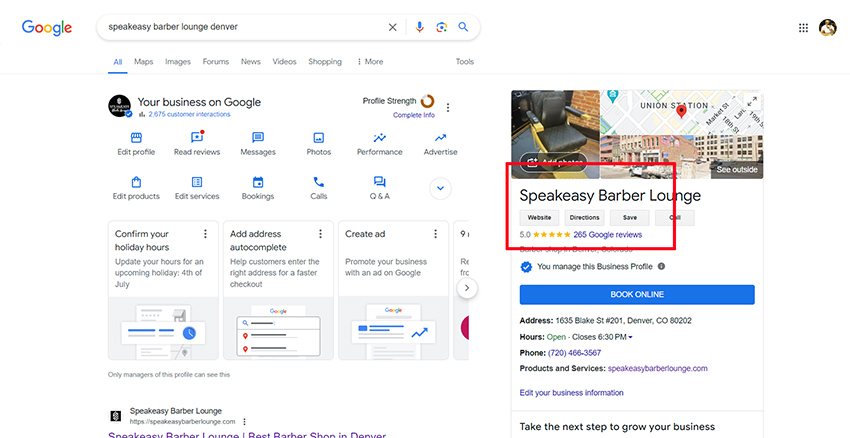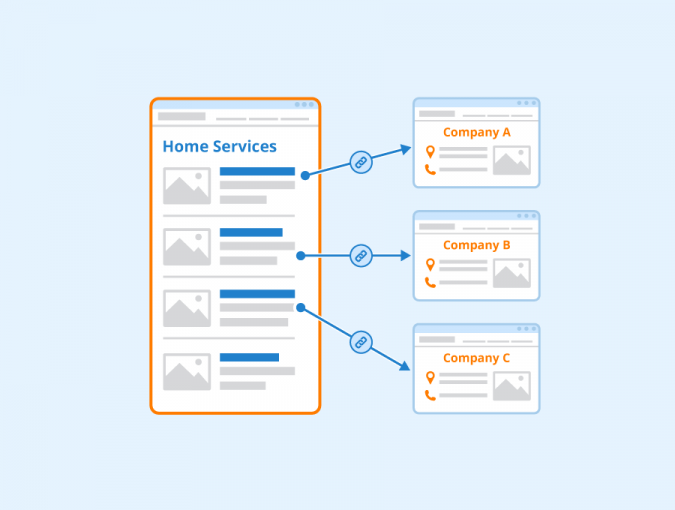Optimize your Google My Business profile with accurate NAP details to boost your local search rankings, which can drive 76% of mobile searches to your store. Target local keywords using tools like SEMrush and create dedicated location pages with unique content. Verify your website is mobile-optimized, as 57% of web traffic comes from mobile devices. Implement local schema markup to enhance visibility and use platforms like BrightLocal for review management. Build local backlinks through collaborations and maintain consistent business listings across directories. Monitor keyword performance using tools like BrightLocal and analyze SEO metrics to stay ahead. Let’s get into the details!
Optimize Google My Business
How can you guarantee your Google My Business profile is fully optimized to boost your local search rankings? Start by ensuring your Google business profile is complete and accurate. Consistent NAP (name, address, phone number) details are essential, as 76% of mobile local searches lead to store visits. Regularly update your profile with posts about promotions, events, and new products to maintain engagement and visibility for better local search results. Use the Q&A feature to answer common inquiries, enhancing relevance. Upload high-quality images, which increase requests for directions by 42% and click-throughs by 35%. Finally, encourage positive reviews to boost your rankings and influence consumer trust, as higher ratings correlate with improved local search performance.

Target Local Keywords
After optimizing your Google My Business profile, focus on targeting local keywords to guarantee your business appears prominently in local search results. Keyword research tools like Google Keyword Planner and SEMrush can be used to identify high-volume local search terms. Integrate these local keywords naturally into your website’s title tags, meta descriptions, headers, and content to improve local rankings.
- Research specific phrases: Combine your service and location (e.g., ‘plumber in [City]’).
- Assess competition: Evaluate competitors using keyword research tools.
- Update keyword strategy: Align with changing local search trends and consumer behavior.
- Optimize website content: Incorporate local keywords throughout your site for relevance.

Create Location Pages
Creating dedicated location pages for each service area is a strategic move to boost your local SEO by targeting specific geographic keywords and enhancing search relevance. To improve your local search ranking, create location pages with unique content addressing local concerns and showcasing services offered. Optimize title tags and meta descriptions with relevant local keywords to increase visibility and click-through rates. Incorporate structured data markup to help search engines understand the geographic context, enhancing your chances of appearing in local search results. Keep your location pages updated with fresh content, local news, and promotions to maintain relevance and engagement. This detailed approach guarantees your business stands out in each targeted area, driving more local traffic and leads.
Mobile-Friendly Website

Since approximately 57% of all web traffic comes from mobile devices, guaranteeing your website is mobile-friendly is essential for capturing this substantial audience and boosting your local SEO. A mobile-friendly website directly affects local ranking factors by enhancing user experience and reducing bounce rates. To strategically optimize your websites, consider the following:
- Implement responsive design to guarantee your site adapts to various screen sizes.
- Aim for load times under three seconds to improve engagement.
- Utilize Google’s PageSpeed Insights to identify and fix performance issues.
- Guarantee touch-friendly navigation for a seamless user experience.
Local Schema Markup
Implementing local schema markup on your website is crucial for helping search engines understand and display your business information accurately in local search results. By using structured data like JSON-LD, you can greatly enhance your visibility, making it easier for potential customers to find you. Local schema markup can boost your chances of appearing in rich snippets and the local pack, leading to higher rankings and increased click-through rates. According to Google, businesses using structured data are 30% more likely to achieve higher rankings. Regularly test and validate your local schema markup with tools like Google’s Structured Data Testing Tool to verify everything is interpreted correctly. Embrace this strategy to stay ahead in the competitive local search environment.
Manage Customer Reviews
Encouraging your customers to leave reviews can dramatically boost your local SEO, as 76% of consumers trust online reviews as much as personal recommendations. Reviews can help increase your chances of appearing in local search results, especially if you maintain a high average rating. To strategically manage customer reviews, follow these steps:
- Ask for reviews: Prompt your local customers to share their experiences.
- Respond to reviews: Show customer engagement by promptly addressing positive and negative feedback.
- Monitor trends: Regularly analyze review patterns to identify areas for improvement.
- Utilize tools: Leverage platforms like BrightLocal to streamline review management.

Build Local Backlinks
Building local backlinks is essential for boosting your local search rankings, as they demonstrate your business’s relevance and authority to search engines within your geographic region. Submit your business to local directories and citation sites to improve NAP consistency and generate valuable backlinks. Collaborate with local bloggers or influencers who can create content linking to your site, leveraging their established audiences. Participate in community events and sponsorships to gain backlinks from local organizations or event pages. Establish local partnerships with other businesses, paving the way for reciprocal linking opportunities. These strategic actions will enhance your local search rankings, driving more targeted traffic to your business and solidifying your online presence.
Consistent Business Listings
Ensuring consistent business listings across all online directories is vital, as 70% of consumers trust businesses with uniform information. To maintain credibility and boost your local search rankings, keep your Name, Address, and Phone number (NAP) identical across platforms. Local citations, which include your NAP details on various websites, are essential for local SEO.

Figure: Web Directory – Author: Seobility – License: CC BY-SA 4.0
Key steps include:
- Claim and optimize your Google Business Profile – Enhances visibility and impacts local search rankings.
- Regularly audit listings using tools like BrightLocal and other BrightLocal alternatives – Identify and correct inconsistencies.
- Ensure NAP consistency – Avoid discrepancies that confuse search engines and users.
- Leverage local citations – Strengthen your online presence with accurate, widespread NAP information.
Strategically managing these elements can greatly improve your local search performance.
Engage on Social Media
Maximizing your local SEO efforts involves leveraging social media to drive traffic, showcase testimonials, and increase community engagement. For your local business, an active social media presence is essential. Over 70% of consumers read online reviews before visiting a business, so use platforms to highlight customer testimonials. Engaging with followers through comments and direct messages fosters a loyal community and can elevate your local SEO campaign. Posting localized content, such as event promotions, increases engagement and shares, enhancing your visibility in local search results. Don’t forget to utilize location tags, as 30% of social media users rely on these features to find nearby businesses, driving more local traffic to your profile and physical location.
Internal Linking Strategy
Leveraging social media’s power, you can further bolster your local SEO by implementing a robust internal linking strategy that enhances site navigation and improves search engine rankings. A strategic internal linking strategy is critical to your local SEO checklist, driving significant ranking signals and boosting user engagement. To optimize your internal links:
- Use keyword-rich anchor text to improve contextual relevance.
- Link to high-authority pages to distribute page authority effectively.
- Ascertain logical link structures to guide users seamlessly.
- Regularly audit and update links to maintain functionality.
Track Keyword Performance
To effectively track keyword performance and refine your local SEO strategy, use tools like BrightLocal’s Local Rank Tracker for detailed monitoring across multiple platforms. This tool lets you track keywords on Google, Google Maps, and Bing to guarantee a thorough view of your local rankings. Regularly assess keyword performance to identify which terms drive traffic and conversions, allowing for strategic adjustments. Employ Local Search Grid to visualize keyword performance in specific geographic areas, providing insights into local market dynamics. Establish a weekly analysis schedule to stay updated on keyword fluctuations, adapting your tactics as needed. Generate white-label reports to present findings, showcasing the success of your local SEO efforts and pinpointing areas for improvement.
Monitor SEO Metrics
Regularly monitoring SEO metrics is crucial for refining your local SEO strategy and ensuring sustained growth in search rankings. You can make data-driven adjustments that bolster your local rankings by closely monitoring key performance indicators. Use Google Analytics to track user behavior and conversion rates from local searches. Don’t overlook online reviews; they not only influence consumer trust but also impact your rankings. Incorporate these essential metrics into your local SEO efforts:
- Local keyword rankings: Track performance with tools like BrightLocal’s Local Rank Tracker.
- Click-through rates (CTR) and bounce rates: Gauge engagement and effectiveness.
- Online reviews and ratings: Monitor and respond to boost credibility.
- Technical SEO audits: Use SEMrush or Moz to maintain site health and resolve issues.
Conclusion
By following this thorough local SEO checklist, you’ll position your business for success. Did you know that 46% of all Google searches seek local information? That means nearly half of your potential customers want businesses like yours. Optimize your Google My Business, focus on local keywords, and guarantee your site is mobile-friendly. By strategically implementing these tactics, you’ll significantly boost your local search rankings and stand out in your community.








